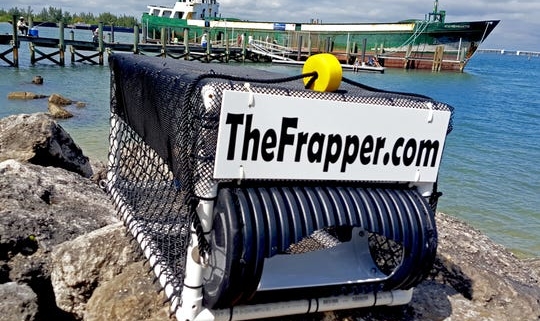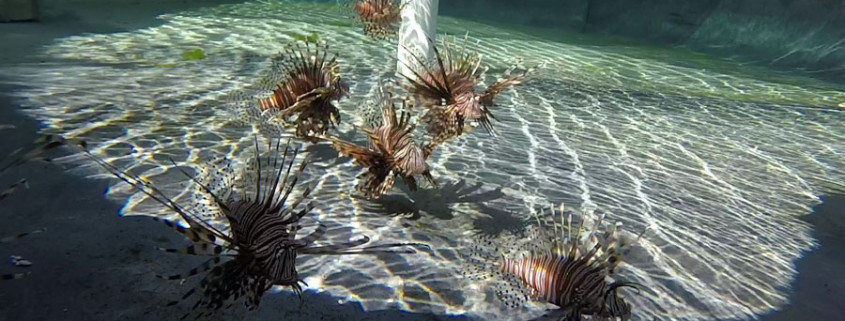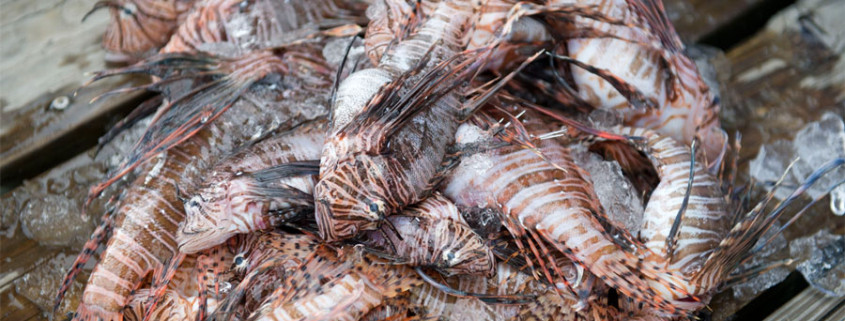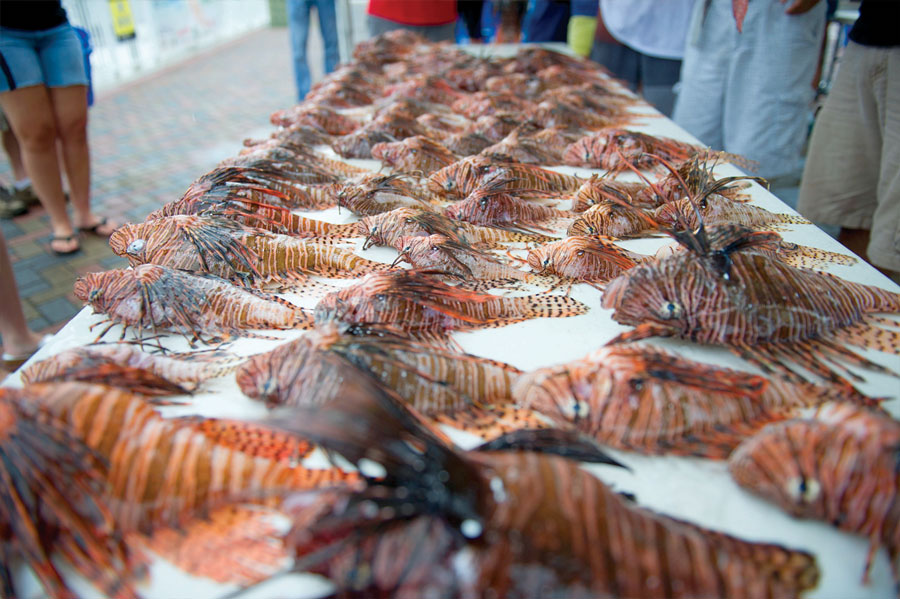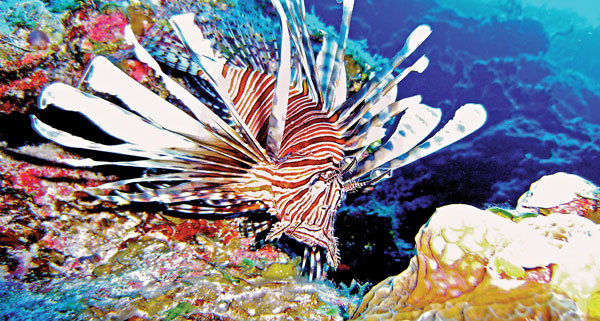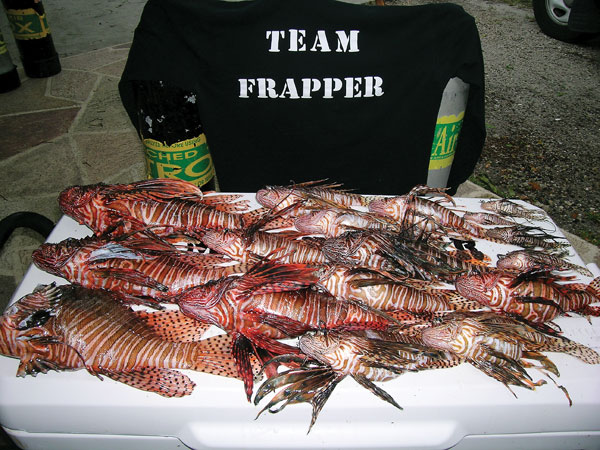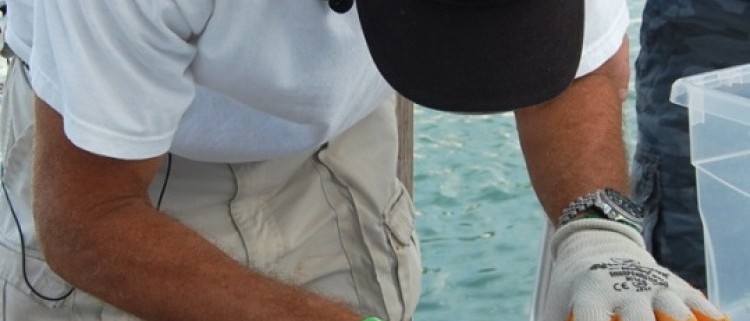Lionfish in the News April 09, 2015
/in Press Articles /by Bob HickersonThank you Ed Killer and the TC Palm staff for your continued coverage of our ongoing lionfish removal efforts! Here are some excerpts from Ed’s article which appeared Apr 10, 2015:
For Bob Hickerson, inventor of The Frapper, the removal of lionfish from South Florida’s ecosystem is serious business.
But the way he figures it, why not have a little fun while eradicating an unwanted pest?
This summer, four events will target lionfish in an effort to raise awareness and spur removal of what has become Florida’s No. 1 most feared marine pest.
The small, but voracious lionfish is beginning to overrun coral reefs and other marine habitat even in the relatively shallow waters of the Indian River Lagoon.
Recent research has discovered that lionfish will inhabit the rock ledges of the Intracoastal Waterway’s channel, sea walls and even red mangrove roots where many other economically important species of game and food fish make their home as juveniles.
As if that isn’t bad enough, these adaptable predators can be found in depths of 300 feet of water miles from the coast as well.
“We see enough of them to be concerned and worried about their spread,” said Hickerson, an avid diver and confirmed lionfish hater from Vero Beach. “They are showing up in larger numbers with larger fish inside the Fort Pierce Inlet and in the Indian River Lagoon.”
Hickerson said it’s very troubling because lionfish can have a huge affect on the lagoon, and there is very little that can be done to control their population explosion.
Hickerson and partners with the U.S. Geographic Survey and Florida Institute of Technology are developing a lionfish trap that could help in the future, once his group can raise enough money to place a few in the Indian River Lagoon.
Divers he is working with also are working on obtaining permissions to dive spots like the Fort Pierce Inlet and areas around the South Bridge and North Bridge to remove lionfish.
“One thing that has been working well is that demand for lionfish fillets is growing,” Hickerson said. “I know Pelican Seafood, in Fort Pierce; Crab-E-Bill’s, in Sebastian; and New England Seafood, in Jensen Beach, are carrying it in their markets, plus many restaurants are starting to offer it on their menus. That’s a big win right there.”
Lionfish fillets have a mild flavor and flaky consistency making them highly desirable by seafood lovers.
Hickerson said this year’s Treasure Coast Lionfish Safari will be part of the Florida Fish and Wildlife Conservation Commission’s Lionfish Removal and Awareness Day on May 16.
The FWC is promoting an effort to see how many lionfish can be removed from Florida’s waters in one weekend.
Hickerson said the FWC will be on site at a lionfish derby in the panhandle, but organizers of the Treasure Coast Lionfish Safari, in Fort Pierce, will Skype in to report the total catch from the first day of spearing and fishing. Last year, teams bagged a respectable 581.
The Lionfish Safari also will feature a division for hook-and-line caught lionfish, live music and lionfish tasting.
On May 17, chefs from area restaurants are encouraged to prepare their favorite lionfish creations for a panel of judges.
These events which are open to any divers and anglers who would like to participate.
LIONFISH REGULATIONS
Florida state and federal regulations
Size limit: None
Bag limit: None
Online: For tips on spearing, catching, cleaning, filleting and biology of lionfish, click here.
WHY ARE YOU KILLING THAT BEAUTIFUL FISH?
/in Press Articles /by Bob HickersonAs seen in Coastal Angler Magazine May 23, 2014
by Bob Hickerson/ Team Frapper
“The lionfish invasion in Florida’s waters… a brief review and update”
The first “official” report of a lionfish in Florida’s waters occurred in 1985 off the Southeast coast. We have also heard of “unofficial” sightings dating back into the 1970s. Most likely a result of many unrelated aquarium owner releases taking place over decades, we are now faced with a booming lionfish population.
It turns out that these guys are not just another pretty aquarium fish. Originally from Indo-Pacific waters, they have adapted well to our Atlantic, Gulf and neighboring Caribbean waters. They are found in waters from 2 to 1000 ft, are able to survive in very low salinities and can tolerate temperatures from the low 50s to the 90s. Females reach sexual maturity in their first year and are capable of producing as many as 20,000 to 30,000 eggs every 4 days. They are voracious feeders capable of reducing local prey by as much as 80%. And, if that is not enough, no natural predator has stepped up yet to regularly consume this spiny, venomous creature. No wonder one scientist described them as:
“Lionfish are in essence a biological pollution, spreading along our coasts, coating our estuaries and reefs, and even seeping down to the depths” (Dr. Pamela J. Schofield, Research Biologist, US Geological Survey, Gainesville, FL).
Divers are becoming aware of the need to remove as many lionfish as possible on their dives. It has become quite a sport. Finally, here is a marine creature we don’t have to feel guilty about removing! New tools have emerged making removals safer and more efficient. Last year FWC declared “Open Season” and made it possible for a diver to remove an unlimited number of lionfish without the need of a Fishing License. Fishing tournaments targeting lionfish are being scheduled throughout the State all year long. Prizes are offered for teams bringing in the “Most”, “Largest” and even the “Smallest” lionfish. If you are interested in participating in one or more of these tournaments, FWC and REEF.org both have websites listing upcoming events.
If you have not tried it yet, I believe that you will find it a very tasty fish! A sweet, mild white meat with a flavor somewhere between flounder and hogfish. Check with your local markets and restaurants. If they do not offer it yet, they should! One way to insure a consistent removal process will be to create a demand in the market place.
We have noted a number of different marine species willing to eat lionfish, but reports of natural predation are few. If I were a betting man, I would put my money on large grouper, snapper and shark species to eventually step up and prey upon lionfish. Until that actually happens, or another predator emerges, let’s all maintain a constant pressure on these invaders and perhaps leave our local potential predators in the ocean.
Report Sightings: nas.er.usgs.gov/sightingreport.aspx
Upcoming Events: http://myfwc.com/fishing/saltwater/recreational/lionfish/events/
Myth-Busting Florida’s Invasive Lionfish as appeared in Coastal Angler Magazine
/in Press Articles /by Bob HickersonFirst reported sightings of a lionfish in Florida waters date back to 1985. Reports slowly increased over the years and eventually resulted in an explosion of sightings around 2009. This is not solely a Florida event but one of international proportions. The affected areas now range from the northern coastline of South America, throughout the entire Caribbean, Central America, Gulf of Mexico and eastern seaboard of the U.S. This is the first time a non-indigenous marine species has been able to effectively establish itself outside of its native range. When fielding questions during our lionfish events, many of the same ones keep popping up. There remains a great deal of mis-information out there! The answers expressed in this article are brief and not intended to be of a scientific nature; but rather targeted to fishermen, divers, recreational boaters and outdoor enthusiasts that may be just becoming aware of this problem.
Why are Lionfish such a big problem?
Lionfish are consuming native juveniles, small reef fish and crustaceans at an unsustainable rate. Think grouper, snapper, lobster, crab and shrimp to name just a few. They are out-competing our already stressed native species. They consume important reef-grazers and algae eaters as well, which will eventually lead to a decline in the health of our marine ecosystems. Adult females are capable of releasing 20,000 to 30,000 eggs every four days. Once fertilized, the buoyant egg masses are dispersed by the prevailing ocean currents. Larvae settle into their new home after a month-long journey. They prefer to live around structure of any kind and have been seen in depths from 2 feet to 1,000 feet and temperatures of 50 to 90 degrees.
How did they get here?
These lionfish are offspring or descendants of those native to the Indo-Pacific region. The consensus among researchers is that a series of intentional, well-meaning, aquarium releases over decades led to this problem. De-bunked theories initially presented include: Hurricane Andrew, ship ballast releases and Atlantis Resort, located in Nassau, Bahamas.
We heard that they were poisonous
Though not poisonous, they do have up to 18 venomous spines which pack quite a nasty toxin should a spine puncture your skin. The spines are located on their dorsal, ventral and anal fins. The spines are super-sharp and solid, not hollow. The spines are used defensively only. De-bunked: The venom is not present in the meat. There are no venom sacs at the base of the spine.
photo by Bob Hickerson/ Team Frapper
Can you die from a sting?
There have been no deaths reported to date. Reactions however, can vary greatly. Typically, instant pain is associated with the slightest envenomating puncture, followed by throbbing pain and swelling. With multiple punctures comes a greater need for immediate medical treatment in the form of pain management and infection avoidance. Symptoms can last from hours to days or more. First aid advice is to apply heat to the wound as soon as possible by immersion in hot, non-scalding liquid of approximately 110 to113 degrees. Check water temperature on a non-affected area first then immerse cleaned wound for as long as needed. We have reports from researchers working with thawed, months-long frozen fish still capable of producing envenomations. De-bunked: Soaking the wound in ice or iced-salt water may seem to provide some short-term relief but will do nothing to denature the venom as heat will.
Once the fish is caught or captured, how do I handle it safely?
Avoiding the spines, euthanize the fish by placing it in icy water. Once dead, trim the spines close to the body with a good pair of shears or scissors. Dispose of the trimmed spines safely and appropriately.
Can they be caught using hook and line?
Only a handful of reports have come in so far. This may become a more common occurrence as their population continues to increase on our deeper reefs. They prefer live fish or crustaceans and can take in prey up to one half their own body size
How big do they get?
While diving in 100 feet of water or less, we are now removing them in the 16 inch – 2 pound-plus range. Reports have come in of those pushing 19 inch – 3 pound-plus range.
Are they good to eat?
Absolutely! I can tell you that we have been eating those locally caught for four years now and consider it one of our favorite fish. The meat is white, flaky, sweet and mild. It has been compared to hogfish, flounder and snapper. Prepare it as you would any other mild fish. Once the spines are removed, clean and fillet as you would any other!
Are restaurants or seafood distributors starting to carry them?
Finally, yes! Ask for lionfish at your favorite seafood restaurant!
If caught, sighted or removed, who should I report this to?
The U.S. Geological Survey maintains a data base on all non-indigenous species. Their website is: http://nas.er.usgs.gov/SightingReport.aspx
How can you help?
Long term —report captures, support local removal efforts, encourage local restaurants and seafood dealers to carry it and, this one may not be too popular with my brother fishermen and women but, since large grouper and snapper seem to have shown an interest in consuming lionfish, it may be best to give them a bit of a break for a while and not always go for the limit. We just may need their help if we ever hope to control this invasion. Short Term—find out about, and participate in Lionfish Derbies and Tournaments, Round-Ups and Safaris.
Bob and his wife Maria conduct public awareness talks entitled “Lionfish: A Perfect Invader?” to fishing clubs, environmental and conservation groups as well as attend outdoor environmental events with their Lionfish education booth. They have formed a group of volunteer SCUBA divers called TEAM FRAPPER that routinely clear lionfish from waters throughout Florida and attend nearly every Lionfish “Derby” or “Safari” held in the state.
Eating Lionfish – a direct contribution to preserving our coral reefs
/in Press Articles /by Bob HickersonIn the U.S. and the Caribbean, lionfish are an invasive species – a top predator with the potential to create massive and irreversible harm to our reef ecosystems. Fortunately for our reefs, the flashy lionfish has caught the attention of the hungriest predators of all People! The “Eat Lionfish” campaign is a way to make the public aware of this growing threat and invite them to be part of the strategy to combat it and enjoy a tasty fish at the same time.
The Bottom Line:
Diners who choose lionfish are not only getting a delicious fish: they are making a direct contribution to preserving our coral reefs and our communities.
Eat sustainable, eat lionfish!
Winning Team Nets $1,700 in Middle Keys Lionfish Tournament
/in Press Articles /by Bob HickersonWeather and a postponement contributed to a low turnout for the Middle Keys lionfish tournament, but one lucky team took home $1,700.
The October 23 tournament in Marathon, organized by the Reef Environmental Education Foundation (REEF) and Florida Keys National Marine Sanctuary, was the second of three Keys-based lionfish roundups aimed at reducing the population of the invasive Indo-Pacific red lionfish in sanctuary waters. The five participating teams captured 21 lionfish during the one-day event out of Marathon, bringing the total number of lionfish captured during the tournaments thus far to 555.
Frapper on Facebook
Follow us on Facebook
Latest from our Blog
 Behavior of Lionfish will be studied on Newest Artificial ReefAugust 16, 2019 - 11:59 am
Behavior of Lionfish will be studied on Newest Artificial ReefAugust 16, 2019 - 11:59 am Lionfish in the News April 09, 2015April 14, 2015 - 5:03 am
Lionfish in the News April 09, 2015April 14, 2015 - 5:03 am WHY ARE YOU KILLING THAT BEAUTIFUL FISH?April 5, 2015 - 7:47 am
WHY ARE YOU KILLING THAT BEAUTIFUL FISH?April 5, 2015 - 7:47 am Myth-Busting Florida’s Invasive Lionfish as appeared in Coastal Angler MagazineMarch 27, 2015 - 5:50 pm
Myth-Busting Florida’s Invasive Lionfish as appeared in Coastal Angler MagazineMarch 27, 2015 - 5:50 pm- Eating Lionfish – a direct contribution to preserving our coral reefsMarch 10, 2015 - 9:02 am
Article Categories
Business Hours
24 Hours a day:
Call: 772.473.0252
Saturday: 10am to 2pm
Sunday: Closed

